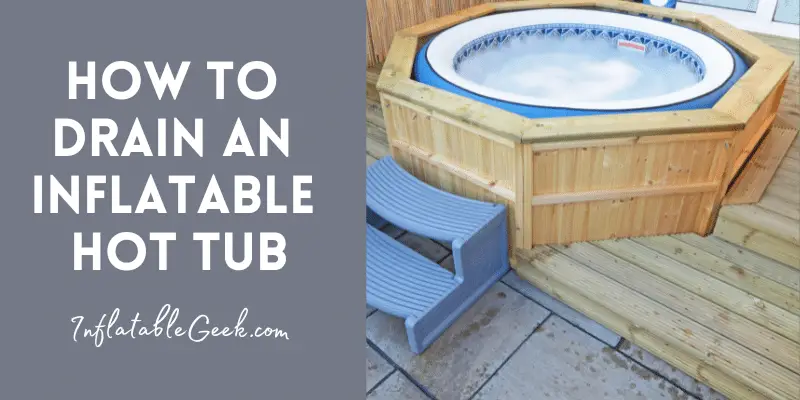Soaking in an inflatable hot tub can be an absolute treat right in your backyard.
Just like traditional hot tubs, inflatable versions require maintenance, including regular draining.
Here is how to drain an inflatable hot tub:
Drain inflatable hot tubs by disconnecting electrical components. Then find the drainage valve. Prepare a drainage area, considering local laws. Attach a hose to the valve. Open the valve slowly, monitoring the flow. Use a submersible pump, if necessary. Clean and inspect before refilling.
This complete guide offers you a step-by-step rundown on how to drain your inflatable hot tub.
Why Draining Is Important
(This post may have affiliate links. Please see my disclosure)

Draining an inflatable hot tub is crucial for various reasons.
First, the water in a hot tub can be a breeding ground for bacteria and algae if left unchanged for an extended period.
These contaminants can cause skin irritations, offensive smells, and even potential health risks.
Second, draining allows you to clean the tub thoroughly, thereby maintaining its structural integrity and ensuring it remains an inviting place to relax.
When your inflatable hot tub is empty, it also gives you a chance to inspect it for damage.
Check for punctures, wear and tear on the inflatable walls, and the condition of the pump and heating systems.
Addressing these issues early can save you a lot of hassle and money in the long run.
When to Drain Your Inflatable Hot Tub
The frequency with which you should drain your inflatable hot tub depends on various factors:
- Usage
- Water quality
- Proper coverage
Generally speaking, it’s recommended to drain and clean the hot tub every 4 to 6 weeks.
However, if you notice any signs of water contamination, like a strange odor, cloudiness, or excessive foam, it’s advisable to drain it immediately.
Heavy usage or having many people use the tub would also necessitate more frequent drainage.
Take note of how often you use the tub and the number of users to gauge the right drainage intervals for your situation.
Tools You Will Need
Before you start draining your inflatable hot tub, make sure you have all the necessary tools on hand.
These usually include a garden hose, a submersible pump (optional), and some towels or absorbent material.
Having the right tools ready will streamline the process and prevent unnecessary delays.
Even if your inflatable hot tub comes with a built-in drainage valve, a garden hose can be useful for directing water to a specific location.
Submersible pumps can accelerate the drainage process, particularly for larger hot tubs.
Towels or other absorbent materials will help you handle any spills or last-minute cleanup.
Safety Precautions
Draining your hot tub involves water and electrical components, so safety should be your primary concern.
Begin by disconnecting the hot tub from the power source to prevent any electrical hazards.
Keep all electrical cords away from the draining area.
It’s also essential to wear appropriate footwear to prevent slips, especially if you’re draining the hot tub onto your lawn or patio.
Make sure to keep children and pets away from the draining area for added safety.
Locate the Drainage Valve
The next step is to locate the drainage valve on your inflatable hot tub.
This is typically found on the bottom or lower sides of the tub.
Check your user manual if you have trouble finding it, as the location may vary between different models.
Once located, ensure that the valve is easily accessible and that there are no obstructions.
You’ll need to have ample space to work around the valve, especially if you’re planning to attach a hose for more controlled drainage.
Prepare the Drainage Area
After locating the valve, you need to decide where you will be draining the water.
Most people opt to drain their hot tubs into their yards or storm drains.
However, be mindful of local laws concerning water drainage. Some areas prohibit draining chemical-laden water into public drainage systems.
Ensure that the area you’re draining into can handle the volume of water from your hot tub.
Make sure it’s free from obstructions and that you won’t be causing any water damage to your own or your neighbor’s property.
Attach a Hose (If Needed)
If you need to direct the water to a specific area, attaching a hose to the drainage valve is your best option.
Make sure the hose is long enough to reach your drainage area and is securely attached to the valve.
Double-check for any leaks before opening the valve completely.
Attaching a hose is especially useful if you’re looking to recycle the water for irrigation or other purposes.
Just remember, if you’ve used chemicals in your hot tub, this water may not be suitable for all types of plants.
Open the Drain Valve
With everything in place, it’s time to open the drain valve.
Ensure that the path for the draining water is clear and open the valve slowly at first.
Monitor the flow and make adjustments as needed. If the water is draining too slowly, consider using a submersible pump to speed up the process.
Ensure that you remain vigilant throughout the draining process.
Keep an eye out for any blockages or hiccups, and be prepared to make quick adjustments to avoid flooding or other issues.
Accelerating the Drainage Process
If you’re in a hurry or if your hot tub holds a large amount of water, you may want to use a submersible pump to speed up the draining process.
Simply place the pump at the bottom of the hot tub, attach a hose if needed, and turn it on.
Make sure to follow all safety guidelines provided with the pump.
Using a submersible pump can drastically cut down the time needed to drain your inflatable hot tub.
However, remember to closely monitor the process to avoid any malfunctions or accidents.
Here is a video on how to drain an inflatable hot tub:
Cleanup and Refill
Once your inflatable hot tub is empty, take the opportunity to give it a thorough cleaning.
Scrub the surfaces to remove grime, water lines, or any other deposits.
Inspect the tub for any wear and tear or potential damage that might need repair.
After the cleaning and inspection, you can proceed to refill your hot tub.
Before doing so, ensure that the drain valve is securely closed to prevent any leaks.
Follow your manufacturer’s guidelines on refilling and treating the water for your specific inflatable hot tub model.
Common Mistakes to Avoid
When it comes to draining your inflatable hot tub, there are some common mistakes you’ll want to avoid.
One big mistake is neglecting to disconnect all electrical devices, such as pumps and heaters, before you start.
Doing so puts you at risk of electrical shock.
Another error some people make is draining the hot tub too quickly.
This could lead to flooding or damage to the surrounding area.
Similarly, it’s a mistake to ignore local laws and regulations regarding drainage. Improper disposal can lead to fines and may even pose a risk to local ecosystems.
Always check local regulations and, if necessary, treat the water before draining it into a public water system.
Water Treatment After Drainage
If you’ve been using water treatments like chlorine or bromine, the water from your hot tub can harm your lawn or garden.
Consider using a neutralizing chemical to balance out any water treatment chemicals before draining your tub.
Most water treatment products come with a set of guidelines for neutralizing their effects.
Typically, these are powders or liquids that you add to your hot tub water shortly before draining.
Keep in mind that you’ll need to wait for a certain period (usually indicated in the product instructions) for the neutralizer to work before you can safely drain your hot tub.
Inspecting and Replacing Filters
Once your inflatable hot tub is drained and cleaned, this is a great time to check your filters.
Over time, filters can become clogged with debris and bacteria, which affects the efficiency of your water circulation and heating.
Hold the filter up to the light: If you can’t see through it, it’s time for a thorough cleaning or even a replacement.
Different filters have different lifespans, and some are washable while others are not.
Always refer to your manufacturer’s guidelines on filter care.
You’ll usually find this information in your user manual or on the manufacturer’s website.
Testing Your Water
Before refilling your hot tub, it’s advisable to test the water source.
Whether you’re using tap water, well water, or any other source, knowing the baseline levels of elements like pH, calcium hardness, and total alkalinity will help you treat your new hot tub water more effectively.
Water testing kits are readily available and are a worthy investment for any hot tub owner.
These kits usually involve adding a water sample to a set of chemicals or dipping a test strip into the water.
The resulting color change will indicate the levels of various elements in your water.
Understanding Chemical Balancers
Balancing your hot tub’s water chemistry is essential for ensuring a clean and safe soaking environment.
However, the process can be confusing for beginners.
Chemical balancers are used to adjust pH, alkalinity, and calcium hardness levels in your hot tub water.
A balanced pH level helps chlorine or bromine work effectively as a sanitizer.
Meanwhile, proper alkalinity levels stabilize the pH, preventing rapid fluctuations that can harm your hot tub’s equipment.
Lastly, adjusting calcium hardness protects against corrosion and scaling.
Each of these balancers is available in granular form and can be added directly to your hot tub water according to the manufacturer’s guidelines.
Seasonal Draining Tips
The season in which you’re draining your inflatable hot tub can also affect the process.
In the colder months, it’s essential to ensure that no water remains in the pipes, as it can freeze and cause damage.
During the summer, you might want to schedule your draining sessions for early morning or late evening to avoid working in the heat.
Each season presents its own set of challenges and opportunities for hot tub maintenance.
For example, autumn leaves can quickly clog up your filters, requiring more frequent checks.
Conversely, summertime is often when you’ll make the most use of your hot tub, necessitating more regular chemical treatments and possibly more frequent draining.
Energy-Saving Tips
Draining and refilling your hot tub consumes energy, from heating the new water to running the pump and filter system.
To save on energy costs, consider a few eco-friendly practices.
First, use a quality cover to retain heat and reduce the energy required to keep the water at your preferred temperature.
Second, run the pump during off-peak hours if your energy provider offers variable rates.
Solar-powered heaters and covers with built-in UV protection can also help you cut down on your energy consumption.
While these solutions may require an upfront investment, they can save you money in the long run by reducing your energy bills.
Upgrading Accessories
After draining and cleaning is also an excellent time to consider any upgrades.
This could be a good moment to invest in a more energy-efficient pump, a better filter system, or even accessories like seats, steps, or cup holders.
Enhancements like these can significantly improve your inflatable hot tub experience.
Upgrading accessories not only adds comfort but can also enhance safety and functionality.
For instance, anti-slip steps can reduce the risk of accidents, and an upgraded cover can offer better insulation, saving you money on heating costs.
Final Thoughts: How to Drain an Inflatable Hot Tub
I know that draining your inflatable hot tub is not fun or glamorous.
But it’s a necessary part of keeping your hot tub running smoothly for years. I hope this guide helps you enjoy lots of warm, spa-like dips in your inflatable.
For even more articles like this one, check out some of the blog posts below.
Related Posts:
